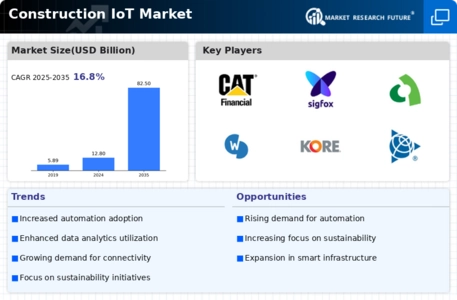Leading market players are investing heavily in research and development in order to expand their product lines, which will help the Construction IoT market grow even more. Market participants are also undertaking a variety of strategic activities to expand their footprint, with important market developments including new product launches, contractual agreements, mergers and acquisitions, higher investments, and collaboration with other organizations. To expand and survive in a more competitive and rising market climate, the Construction IoT industry must offer cost-effective items.
Manufacturing locally to minimize operational costs is one of the key business tactics used by manufacturers in the Construction IoT industry to benefit clients and increase the market sector. In recent years, the Construction IoT industry has offered some of the most significant advantages to the construction industry. Major players in the Construction IoT market, including Caterpiller Inc., Sigfox, Oracle Corporation, CalAmp Corp., Losant IoT, Giatec Scientific Inc., WorldSensing, Kore Wireless, Trimble Inc., Autodesk Inc., and others, are attempting to increase market demand by investing in research and development operations.
Trimble Inc. is a well-known American technology company headquartered in Sunnyvale, California. Founded in 1978, Trimble is a leading provider of advanced positioning, mapping, and geospatial technology solutions. The company specializes in developing hardware, software, and services that are used in a wide range of industries, including construction, agriculture, surveying, and transportation. Trimble's products and services are instrumental in improving productivity, efficiency, and sustainability in various applications. In 2022, Trimble acquired Viewpoint Systems, a provider of construction management software, for $1.2 billion.
The acquisition strengthens Trimble's position in the construction technology market and gives it access to Viewpoint's customer base and expertise in construction management software.
Bentley Systems, Incorporated is an American software company headquartered in Exton, Pennsylvania. Founded in 1984, Bentley Systems is a leader in providing software solutions for infrastructure and engineering professionals. The company specializes in software applications that support the design, construction, and operation of infrastructure projects, including buildings, roads, bridges, utilities, and industrial facilities. Bentley's software covers various aspects of infrastructure, such as building information modeling (BIM), project management, geospatial analysis, and asset performance management. In 2021, Bentley Systems acquired SYNCHRO, a provider of 4D BIM and construction scheduling software, for $500 million.
The acquisition gives Bentley Systems access to SYNCHRO's technology and expertise in 4D BIM and construction scheduling, which will help it develop more comprehensive solutions for construction IoT.

















